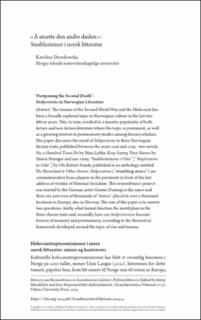| dc.contributor.author | Drozdowska, Karolina | |
| dc.date.accessioned | 2023-09-11T06:32:07Z | |
| dc.date.available | 2023-09-11T06:32:07Z | |
| dc.date.created | 2023-08-28T08:48:55Z | |
| dc.date.issued | 2023 | |
| dc.identifier.citation | Scandinavistica Vilnensis. 2023, 17 (3), 447-464. | en_US |
| dc.identifier.issn | 2029-2112 | |
| dc.identifier.uri | https://hdl.handle.net/11250/3088522 | |
| dc.description.abstract | The trauma of the Second World War and the Holocaust has been a broadly explored topic in Norwegian culture in the last ten–fifteen years. This, in turn, resulted in a massive popularity of both fiction and non-fiction literature where the topic is prominent, as well as a growing interest in postmemory studies among literary scholars. This paper discusses the motif of Stolpersteine in three Norwegian literary texts, published between the years 2016 and 2019: two novels, No, a Hundred Times No by Nina Lykke, Keep Saying Their Names by Simon Stranger and one essay, “Snublesteinene i Oslo” [“Stoplersteine in Oslo”] by Ole Robert Sunde, published in an anthology entitled The Homeland & Other Stories. Stolpersteine (“stumbling stones”) are commemorative brass plaques in the pavement in front of the last address of victims of National Socialism. This remembrance project was started by the German artist Gunter Demnig in the 1990s and there are now tens of thousands of “stones” placed in over a thousand locations in Europe, also in Norway. The aim of this paper is to answer two questions: firstly, what formal function the motif plays in the three chosen texts and, secondly, how can Stolpersteinene become bearers of memory and postmemory, according to the theoretical framework developed around the topic of war and trauma. | en_US |
| dc.language.iso | nob | en_US |
| dc.rights | Navngivelse 4.0 Internasjonal | * |
| dc.rights.uri | http://creativecommons.org/licenses/by/4.0/deed.no | * |
| dc.title | «Å utsette den andre døden»: Snublesteiner i norsk litteratur | en_US |
| dc.title.alternative | «Å utsette den andre døden»: Snublesteiner i norsk litteratur | en_US |
| dc.type | Peer reviewed | en_US |
| dc.type | Journal article | en_US |
| dc.description.version | publishedVersion | en_US |
| dc.source.pagenumber | 447-464 | en_US |
| dc.source.volume | 17 | en_US |
| dc.source.journal | Scandinavistica Vilnensis | en_US |
| dc.source.issue | 3 | en_US |
| dc.identifier.doi | 10.15388/ScandinavisticaVilnensis.2023.22 | |
| dc.identifier.cristin | 2170012 | |
| cristin.ispublished | true | |
| cristin.fulltext | original | |
| cristin.qualitycode | 1 | |

